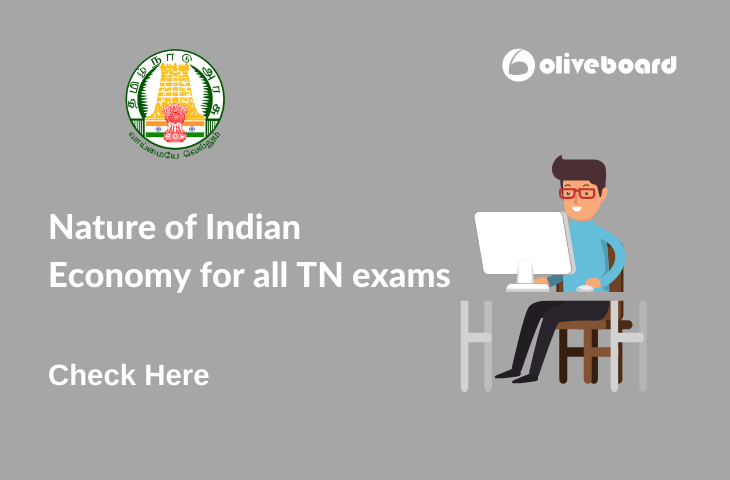TNPSC has released its annual planner 2022. Notifications of various group exams can be expected soon. It’s a wonderful opportunity for aspiring candidates. To help you in your preparation, we have come up with a study blog on the topic of the Nature of the Indian Economy to help you in your preparation.
Nature of Indian Economy e-book | Download link
Click on the link provided below to download the e-book.
How to Download Free e-book PDF?
- Click on the given download link for Tamil and English. You will be taken to Oliveboard’s FREE Ebooks Page. Alternately, you can download the Oliveboard Android App to access these on your smartphone.
- Register/Login on to the Free E-Books Page of Oliveboard (It is 100% free, You just enter your valid email id and a password to be able to download the PDF).
- Once logged in you’ll see the message “Please click here to download the Free Ebook“. Click on the message to download that particular ebook.
Nature of Indian Economy
Basics of an Economy
- Economy is economics at play in a certain region such as a city, state or country. For instance, Indian economy denotes the economy of India as a whole.
- Economics is the study of how goods and services are produced, distributed and consumed.
- Traditionally, the subject matter of economics has been studied under two broad branches: Microeconomics and Macroeconomics.
Microeconomics
- It studies the behaviour of individual economic agents in the markets for different goods and services.
- For example,analyzing the demand and supply of a good/service.
- It examines the functioning of the particular sector of the economy.
Economic agents are those individualsor institutions which take economic decisions. They can be
- Consumers who decide what and how much to consume.
- Producers of goods and services who decide what and how much to produce.
- Entities like the government, corporation, banks.
Macroeconomics
- This is the study of the economy as a whole by focusing on aggregate measures.
- For example,studying total output, employment and aggregate price level and their change over time.
- It examines the various interlinkages that exist between the different sectors of an economy. For example, the effects of inflation on unemployment.
Organization of Economic Activities
- Production, exchange and consumption of goods and services are among the basic economic activities of life.
- Every economy faces the problem of allocating the scarce resources to the production and distribution of different goods and services among the individuals within the economy.
- Based on how an economy is organized to address this problem, three models of economic system evolved, namely-
- Market Economy
- State Economy
- Mixed economy
- These models also decide the role of the state in an economy.
Market Economy
- A market is a set of arrangements where economic agents can freely buy or sell the products.
- In market economy, the decisions of what to produce, how much to produce and at what price to sell are taken solely by the market.
Features
- There is private ownership of means of production.
- The role of government is absent or minimal. State/government play a passive role as a regulator.
- It emphasizes on the ‘division of labour’ and ‘laissez faire’ (non-interference by the government).
- This form of economy was proposed by Adam Smith in his work “Wealth of Nations” (1776).
- United States of America and European countries are the best examples of this model.
State Economy
- The government or the central authority plans all the important activities like production, distribution and pricing in the economy.
Features
- The role of government is high.
- The government may even produce the goods and services that it thinks are much needed for equitable distribution.
- Government carries out the role of producer/supplier of private goods and services like food, clothing as well as public goods and services like roads, defence, etc.
- This form of economy was proposed by Karl Marx.
- There are two versions of the state economy, namely
| Socialistic economy | Communist economy |
| Collective ownership of themeans of production (Land, Labour and capital). A large role of state in running the economy. Erstwhile USSR followed this model. | State ownership of means of production. Absolute power of state in running the economy. China, before 1980s followed this model. |
Mixed Economy
- It is a blend of both market economy and state economy.
- Under this system there is freedom of economic activities as well as government interferences for the social welfare.
- It evolved as a response to the Great depression in 1929 in the USA, which marked the setback of free market theory.
- In 1936, the English economist John Maynard Keynes proposed a new approach which suggested ‘strong government intervention’in the economy along with ‘freedom of market’.
- Presently, most countries follow this model.
Download the free ebook on Nature of Indian Economy for complete information on the topic for TNPSC exams. For guidance and practice for TNPSC exams, download the Oliveboard app.
Also Check:
